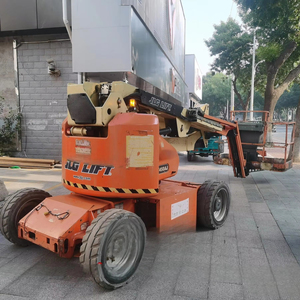(245 products available)


















































































































































































































As one of the popular mobile crane types, JLG cranes refer to the lift machine that provides vertical and horizontal access to work at elevated places. JLG cranes are widely used in the construction and maintenance industries to reach high areas where traditional ladders or scaffolding would not be practical or safe. It works by extending an arm (called the boom) that is mounted on a wheeled vehicle. There are many popular types of JLG cranes as below.
Telescopic Boom Lift:
The telescopic boom lift is one of the most commonly preferred types of JLG lifts. Its primary characteristic is its extendable arm that can be retracted and extended to provide access to elevated areas. Moreover, the telescopic boom lift often comes with a platform or bucket at the end of the arm where workers can stand and carry out their tasks.
Articulated Boom Lift:
The second commonly used type of JLG lift is the articulated boom lift. The articulated boom lift features a two or more jointed arms. This feature allows the arms to move and bend in multiple directions, providing access to areas that are not directly overhead. In addition, the articulated boom lift also moves up and down, giving access to work at different heights.
Electric Scissor Lift:
An electric scissor lift is a kind of aerial platform that moves vertically to provide access to high work areas. The key feature of an electric scissor lift is its scissor mechanism, which consists of interlocking pieces that fold and unfold in a crisscross pattern.
Although there are products such as rough-terrain scissor lifts and electric generator-powered scissor lifts, their functionality remains the same. An electric scissor lift is primarily used for indoor or flat surface applications, while rough-terrain lifts are used in off-road and uneven terrain conditions.
The crane's specifications depend on what type of JLG crane is being considered for purchase or use. They may include things like the maximum height, lift capacity, and weight of the crane.
Some parts of a JLG crane require routine maintenance - more than any other tasks. This helps to prevent unexpected breakdowns and prolongs the life of a crane. During the maintenance, the following actions are usually taken:
In addition to this, routine inspections of the crane are carried out based on the manufacturer’s recommendations or local regulations. The inspections help to identify crane parts that need to be maintained or repaired.
Construction and building maintenance:
JLG aerial lifts or access platform types are one of the most typical usages of the JLG crane. The high-reaching feature makes them excellent for mending high-roofs and installing components up there. JLG scissors and boom lifts are types of aerial lifts. They also work for interior tasks or assembling high racks in stores.
Utility and infrastructure projects:
JLG MEWPs are used by utility companies and telecommunication to install and maintain street lighting, power lines, antennas, and cables. Besides, the boom type is usually selected for working on traffic signs and billboards.
Transport and logistics:
In warehouses and the LOG industry, JLG warehouse cranes are often employed for stacking goods, picking orders, and performing inventory counts. They are fantastic substitutions for forklifts when working at height.
Film, theater, and live events:
JLG tower lifts are often used to set up lighting, sound equipment, and stage props. They also help make the camera move smoothly to create different shooting angles and perfect the action's filming from different heights.
Emergency response:
JLG fire trucks are valuable tools for firefighter hands. The telescoping crane helps the firefighters quickly reach and rescue people in an emergency situation like a fire. They also allow them to access the seat of the fire and extinguish it from above.
To begin with, strong needs analysis should be conducted to determine what types of aerial working environments should be focused on and what requirements such as working height and load capacity correspond to. The match of functional features is also crucial.
Whether choosing a JLG crane or other types, buyers should choose a reputable supplier with an extensive selection. In addition to product variety, attention should also be paid to important details such as the qualifications and reputation of the supplier and the degree of after-sales support service. For example, a comprehensive warranty and repair services network can give the buyer peace of mind in the event of subsequent purchasing and equipment maintenance needs. In addition, the user manual and operating guidelines provided by the supplier can help the buyer use and maintain the equipment correctly to extend its service life.
Q1: What type of crane is the JLG 800S?
A1: JLG's big telehandler is the 800S model. Telehandler cranes are similar to forklifts in that they employ a telescoping arm to deliver materials to places that are not easily accessible.
Q2: How do JLG cranes work?
A2: The lift of an aerial crane is controlled by remote or man entry control. In the case of remote control, the crane operator will use a joystick and buttons to move the crane directionally, raising or lowering the platform.
Q3: What does JLG stand for?
A3: The name JLG comes from its founder, John L. Gifford.
Q4: What is the biggest JLG crane?
A4: JLG 1300S SkyPower is the biggest model in the JLG skycrane category with a dimension of 4,048mm.